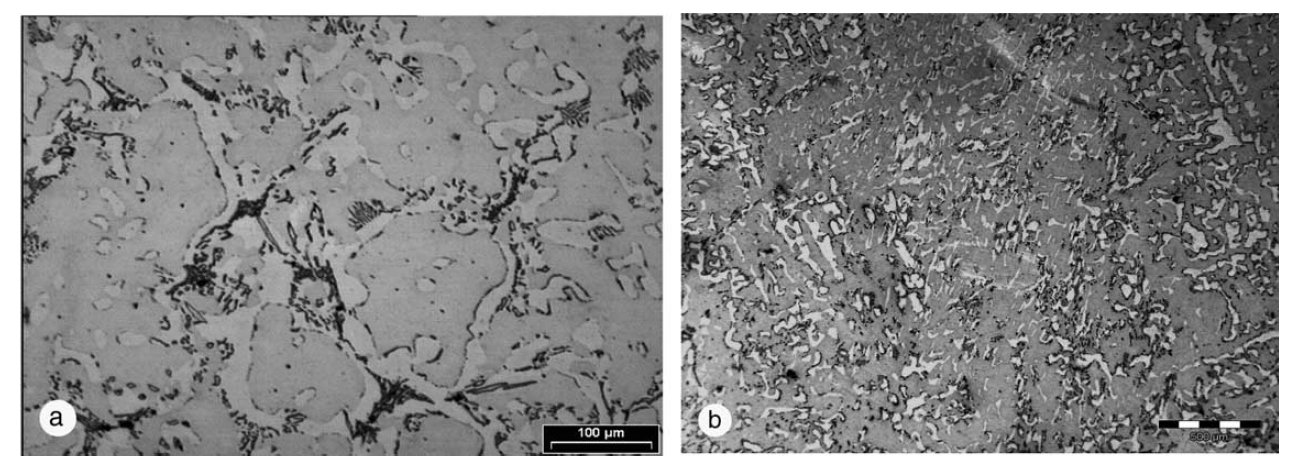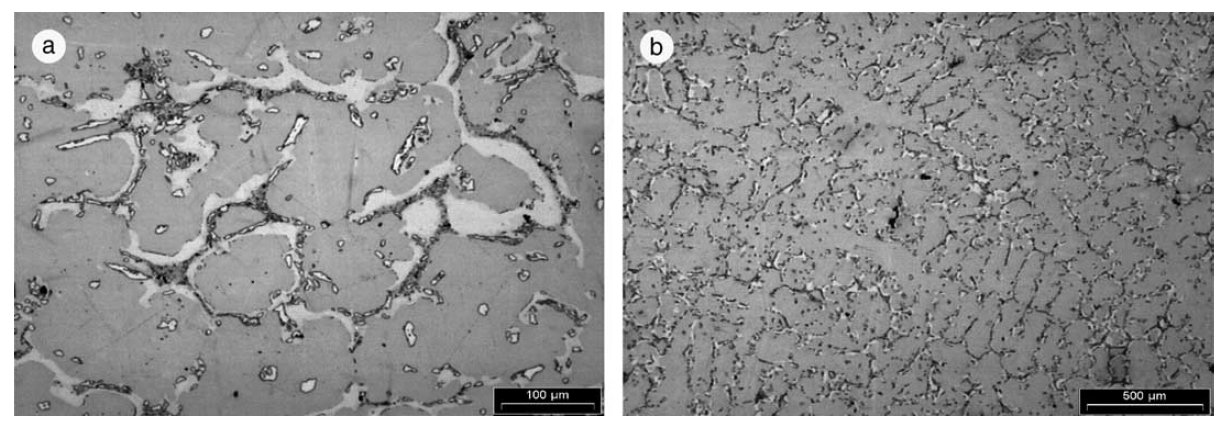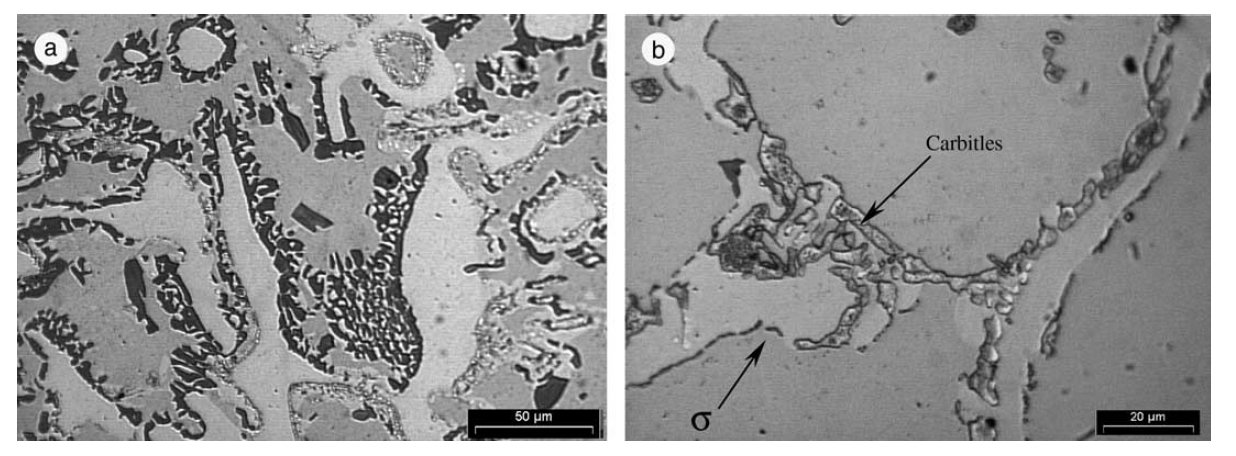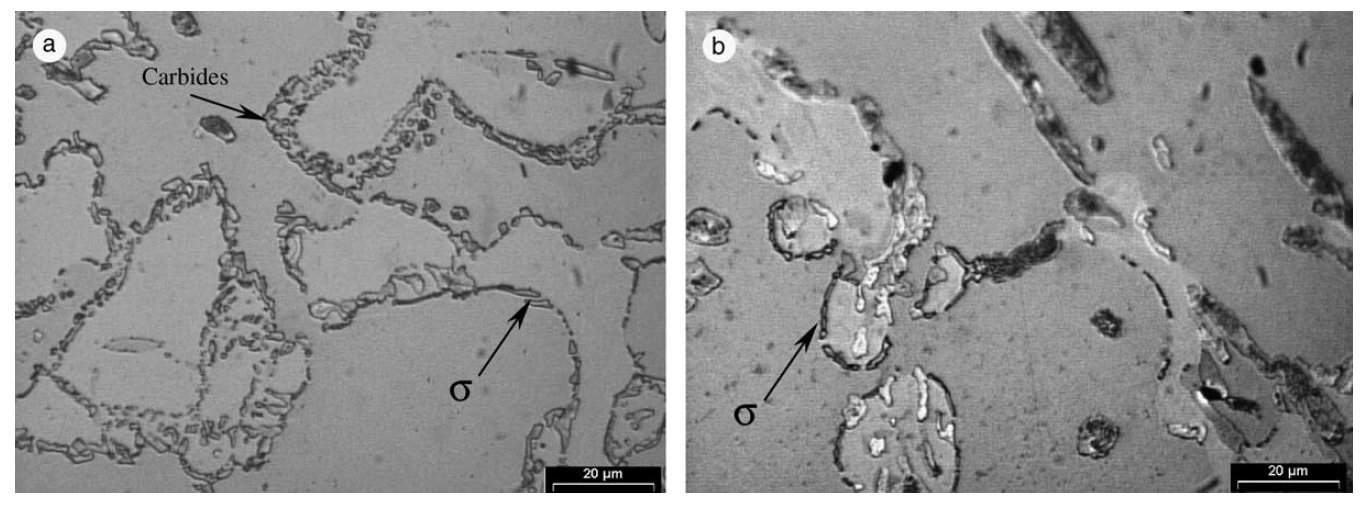
Alphabetical Index
Chemical Composition of Steels
Keyword Search
Steel Names
Alloyed Steels
Carbon Steels
Cast Irons
Chromium Steels
Cold Work Tool Steels
Creep Resistant Steels
Hot Work Tool Steels
Molybdenum Steels
PM steels
Stainless Steels
Structural Steels
Tool Steels
Vanadium Steels
White Cast Irons
M2C Carbides
M3C Carbides
M7C3 Carbides
M23C6 Carbides
MC Carbides
Light Microscopy
EDS/WDS Microanalysis
Scanning Electron Microscopy
Transmission Electron Microscopy
X-Ray Diffraction
Help
Contact Us
Home
Cr23C6 and Cr7C3 carbides in heat resistant steel

Table 1: Chemical composition of the steel samples (wt.%).

Figure 1: As-cast microstructure of steel 1. Scale bars: 100 µm.

Figure 2: As-cast microstructure of steel 2. Scale bars: 100 µm.

Table 2: Carbides observed in the steel samples.

Figure 3: Microstructures of steels 1 and 2 after heat treatment at 1023 K for 50 h, of the as-cast samples; (a) steel 1, (b) steel 2. Scale bars: 50, 20 µm.

Figure 4: Microstructures of steels 1 and 2 after heat treatment at 1023 K for 50 h, of the samples homogenized at 1323 K. (a) Steel 1, (b) steel 2. Scale bars: 20 µm.
Carbide name: Cr23C6, Cr7C3
Record No.: 1031
Carbide formula: Cr23C6, Cr7C3
Carbide type: M23C6, M7C3
Carbide composition in weight %: No data
Image type: LM, SEM
Steel name: Heat resistant steel
Mat.No. (Wr.Nr.) designation: No data
DIN designation: No data
AISI/SAE/ASTM designation: No data
Other designation: No data
Steel group: Heat-resistant steels
Steel composition in weight %: See the table 1.
Heat treatment/condition: The chemical composition of the castings analyzed in
this study, as determined by means of emission spectrometry
(SPECTROLAB), is given in Table 1, where
the samples were labeled as steels 1 and 2. The figures
match the usual composition range stated for HC-type
steel (UNS J92605, A297, A608); slight differences in
composition can be observed for corresponding elements
in both samples. The Sigma-phase precipitation
treatment for steels 1 and 2 (1023 K for 50 h) was performed
on the as-cast microstructure and also after
homogenization annealing at 1323 K for 6 h. The
microstructural characterization of both alloys was
carried out by means of quantitative metallography
(ZEISS AXIOTECH, OLYMPUS BX60 and OLYMPUS
VANOX) and scanning electron microscopy
(JEOL JSM 840). The specimens were etched with
Emanuel reagent (30 g K3FeCN6, 30 g KOH, 60 ml
H2O) at 323 K for 25 s. The component phases were
quantitatively determined by image analysis. On the
other side, the carbides were identified by means of Xray
diffraction (SIEMENS D5000, monochromatized
Cu Ka radiation, k ¼ 0:15406 nm, 40 kV, 30 mA) after
extraction by electrochemical dissolution at 1,5 V (5 g
C2H2O4, 200 ml HCl, 1000 H2O).
Note: The influence of solidification microstructure on r-phase precipitation in two refractory stainless steels (26Cr–3Ni) with different
microstructures is analyzed. Depending upon cooling rates the existence of Cr7C3 strongly increases the r-phase precipitation rate,
whereas Sigma precipitation is delayed when this carbide is not present in the alloy.
The microstructure of the as-cast samples is shown in
Figs. 1 and 2, where the bright etching constituent is
austenite while ferrite is depicted by the dark etching
areas. In Fig. 1(a) two types of primary carbides can be
observed, one of them being distributed as small islands
inside the austenite grains and the other one precipitated
as an eutectoid component along the austenite–ferrite
interface. On the other side, only one type of carbide
was found in steel 2, as disclosed in Fig. 2(a). The X-ray
identification of the carbides is detailed in Table 2; here
Cr23C6 and Cr7C3 were detected in steel 1 in the weight
ratio of 49/51 while only Cr23C6 was contained in steel 2.
The total amount of extracted carbide was approximately
7 wt.%. Figs. 1(b) and 2(b) show the size of the
solidification dendrites, which are very much smaller in
steel 2 as compared with steel 1, which suggests that steel
2 solidified at a faster rate. The microstructure of the ascast
samples after 50 h of annealing at 1023 K are shown
in Fig. 3, where it can be observed that r-phase nucleates
along the austenite–ferrite interface and grows into
the ferrite grains. The relative amount of r-phase was
about 20 wt.% in steel 1 but only a few % in steel 2. On
the other hand, Cr23C6 was the only type of carbide
contained in both steels after homogenization of the ascast
samples at 1323 K for 6 h. In fact, according to
Table 2 the Cr7C3 had completely disappeared. Samples treated at 1023 K for 50 h after homogenization at 1323
K are shown in Fig. 4, where Sigma-phase is not yet visible.
Links: No data
Reference: Not shown in this demo version.